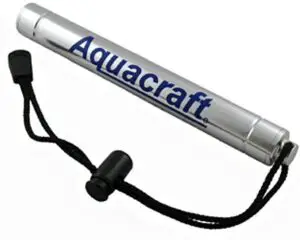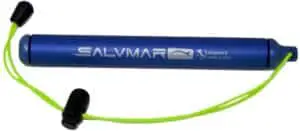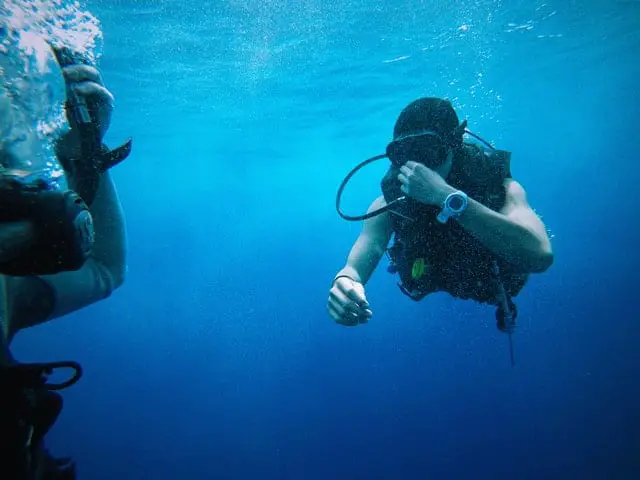If you’re a scuba diver, you know how difficult it can be to converse with fellow divers when underwater. Aside from communicating with other divers using scuba hand signals, you’ll also need to gain their attention when they’re distracted by anything. Using an underwater sound device will greatly enhance your experience.
Getting your diving buddy’s attention when they are preoccupied with anything else is equally critical in an emergency circumstance.
Consider utilizing an underwater sound device to make the most of your dives and prevent potentially life-threatening circumstances. It is a useful underwater signaling gadget to add to your essential scuba diving equipment list.
| Underwater Sound Device | Brand | Our Rating | Check on Amazon |
|---|---|---|---|
 | Mares - Magnetic Shaker Diving Communication Device | [su_button url="https://www.amazon.com/Mares-Magnetic-Shaker-Diving-Communication/dp/B002ZDP7PI?tag=beka3687-20" target="blank" style="default" background="#E03F00" color="#FFFFFF" size="5" wide="no" center="no" radius="auto" icon="" icon_color="#FFFFFF" text_shadow="none" desc="" onclick="" rel="" title="" id="" class=""]Check Price[/su_button] | |
 | House of Scuba - Noise Signal Underwater Device | [su_button url="https://www.amazon.com/Aquacraft-Aluminum-Diving-Signal-Underwater/dp/B004G8LPVU?tag=beka3687-20" target="blank" style="default" background="#E03F00" color="#FFFFFF" size="5" wide="no" center="no" radius="auto" icon="" icon_color="#FFFFFF" text_shadow="none" desc="" onclick="" rel="" title="" id="" class=""]Check Price[/su_button] | |
| SALVIMAR - Underwater Shaker Noise Maker for Diving | [su_button url="https://www.amazon.com/SALVIMAR-Underwater-Shaker-Spearfishing-Accessories/dp/B00S6SXO6U?tag=beka3687-20" target="blank" style="default" background="#E03F00" color="#FFFFFF" size="5" wide="no" center="no" radius="auto" icon="" icon_color="#FFFFFF" text_shadow="none" desc="" onclick="" rel="" title="" id="" class=""]Check Price[/su_button] |
BEST UNDERWATER SOUND DEVICE – TOP 3 CHOICE
OUR NUMBER 1 CHOICE
[wp-review id=”3519″]
UNDERWATER SOUND DEVICE – STRONG CONTENDERS
[su_service title=”House of Scuba – Noise Signal Underwater Device” icon=”icon: star” icon_color=”#2D3092″ size=”32″ class=””][/su_service]

This underwater signal device is made of lightweight aluminum. And because of its sturdy design, it will withstand the usual hits and stresses of diving expeditions.
It measures 7 inches in total length. You can now easily attract your buddy’s attention underwater. All you have to do is shake it from side to side to get a loud, effective signal.
This purchase includes an attached safety lanyard. This is especially useful for instructors or friends who are more than 5 meters apart. You may add a couple of tiny magnets to the outside and fix them using heat shrink tape to keep it from rattling. By acquiring this communication gadget, you can secure a safe underwater experience.
[su_service title=”SALVIMAR – Underwater Shaker Noise Maker for Diving” icon=”icon: star” icon_color=”#2D3092″ size=”32″ class=””][/su_service]

Using this gadget is the finest approach to getting your friend’s attention. Includes lanyard for creating noise This is the easiest approach to get the attention of a group or dive partner while diving or submerged in water.
It is good for both scuba diving and free diving. This shaker features a metal aluminum body and an inside metal ball that makes a long-distance underwater noise.
It has a length of 7 inches. This is an excellent device since it allows you to communicate with someone who is at least 5 meters away. Extremely effective for a more secure underwater experience. The strong metal shell makes it extremely robust, even during intensive underwater adventures.
Types of Underwater Communications

Communication may frequently be the difference between a successful dive and major risks when diving. Divers who find themselves with empty oxygen tanks or broken equipment must be able to communicate their needs to their friends.
Alternative ways of underwater communication are essential if you are unable to talk correctly during a dive. Fortunately, there are various options for accomplishing this.
➖ The Transceiver
This is a wireless gadget that allows divers to communicate vocally. But the voice may not always be intelligible due to nasal plugs and regulators.
Some earlier systems have full-face masks, but current devices are considerably smaller and strap around the diver’s head.
When it comes to underwater communication, they are a strong first line of defense.
➖ The Dive Slate
This is where diving slates come into play. A diving slate is often a piece of plastic, similar to a whiteboard, with a wax pencil attached.
These can range in size from large enough to write complete phrases to small enough to attach to a wrist.
There are magnetic variations, as well as “diving notebooks” made of numerous sheets of thin plastic. Dive slates are essential components of diving equipment.
➖ The Hand Signals
Divers have one more way to “speak” to one another, and it is the most often utilized method of underwater communication. That is hand signals.
There is an agreed-upon set of diving signals that may be used to swiftly and simply transmit information in an emergency, and they only require the diver’s hands.
These are restricted by visibility, but even a rookie diver should be able to indicate to people around them that they need assistance and comprehend what other members of their diving party are signaling to them.
➖ The Lights
Diving lights aren’t as useful as a dive slate or hand signals for communicating, but they’re useful nonetheless.
A dive light is a form of underwater illumination that you may attach or hold in your hand to illuminate your surroundings.
It’s important if you’re diving at night, but it’s also beneficial during the day if you’re diving deep because sunlight doesn’t travel very far into the sea. They can also be used as a tool of communication.
To grab your diving buddy’s attention, you may also beam your light on them or quickly turn your light on and off.
➖ The Rope Tugs
This approach does not allow you to communicate with your diving mates, but it does allow you to signal to the boat operator or tender.
Whether the boat operator tugs on the rope once, it means he or she is checking to see if you are okay. If you haul the rope once, you’re saying you’re fine.
And if the boat operator drags the rope twice, it means he or she wants you to stay where you are. If you tug the rope twice, you are indicating that you intend to remain where you are.
Different Types of Underwater Noisemakers

Communication underwater can be difficult and is often limited to a narrow range of hand gestures. Getting your diving buddy’s attention might be much more difficult.
Fortunately, there are a few noisemakers that may be used to communicate.
〰️ Shaker
Many diving instructors have one of these attached to their BCD, which is perhaps the most well-known choice. Most are rather sturdy and produce a clear sound that can be heard from a reasonable distance.
〰️ Horn
These gadgets often link between your low-pressure hose and your BCD, making clangor with the air from your cylinder. And you can also hear these from quite a distance, even on the surface.
〰️ Tank Banger
A tank banger is a simple gadget made of hard material and an elastic band. You wrap it on your cylinder and produce noise by snapping the hard plastic or metal against your tank.
〰️ Rattle
This is fundamentally the same as a commercial shaker, consisting of some hard metal within an airtight container.
Old camera film canisters are a famous alternative, although they are becoming increasingly scarce. Another option is to use a medication bottle. Anything from BBs to a simple nut will serve for the metal.
Since not all canisters have an easy method to link them to a BCD, you may have to devise or hold the shaker in your pocket.
〰️ Ring
This is an excellent option because it does not need the attachment of anything to the apparatus. When pounded on your tank, a metal band makes a tremendous noise.
The noise is gentler than the other alternatives, it just attracts the attention of people in your immediate proximity. But it may occasionally be too quiet.
Effective Underwater Communication Techniques

Divers cannot just open their mouths to tell what is happening underwater.
As a result, knowing basic hand signals is a vital aspect of having an open-water certification. However, speaking successfully underwater takes more than just a few fundamental signals.
❕ Learn the Fundamentals
The primary hand signals that divers must understand encompass two critical kinds of information. Such as up and down, stop and turn around, as well as situational indications such as I’m fine, low on air, or something is wrong.
These fundamental signals are the same throughout the planet. Master them in the same way you would any other skill, such as mask clearing.
❕ Talk Topside
Nonstandard hand signals, such as signs for marine life, might differ depending on the individual or location.
Before you jump in the water with a new dive buddy, go over the hand signals you could employ. In their predive briefings, experts frequently discuss their most prevalent hand signals.
❕ Make Some Noise
Since sound travels more effectively through water than through air, creating a lot of noise may be an effective technique to catch someone’s attention.
This may be as easy as knocking on your tank with the grip of your diving knife. But there are shakers, tank bangers, and air-powered noisemakers available.
❕ Make Yourself Visible
Don’t merely toss a brief sign while providing signals. Convey your hand up in front of you, then make the gesture slowly and gradually inside your buddy’s line of view.
Don’t presume the other diver notices you, instead, wait for a reaction before proceeding.
❕ Devise Your Own Language
If you and a buddy dive together often, or if you undertake a certain activity daily. Such as photographing models underwater, you’ll most likely establish your own specialized transmission.
This may be a terrific method to communicate underwater — just be sure to explain your signals if you’re diving with someone new.
Frequently Asked Questions
Q: Is there a technology that allows you to communicate underwater?
A: Casio’s latest underwater communications gadget, the Logosease, now lets you converse with your dive buddies. You may begin conversing from 45 feet away and at a depth of 130 feet.
Q: Is it possible to converse underwater?
A: Yes, you certainly can. Divers can communicate with one another underwater thanks to the development of special underwater communication devices.
Q: Is wireless communication possible underwater?
A: Today, underwater sensors and land sensors cannot interchange data because they employ distinct wireless signals that only function in their respective mediums. Radio waves that pass via air fade quickly in water.
Q: What should you use to write underwater?
A: A normal diving slate is the most basic and perhaps most often used underwater writing equipment.
Q: Is sound more audible in water?
A: Sound travels quicker in water than in air because water particles are more tightly packed. As a result, the energy carried by sound waves is transmitted more quickly. This should increase the perceived volume of the sound.
Q: Can you communicate while wearing a diving mask?
A: Full-face masks have a regulator or a snorkel as part of the mask design. Full-face masks allow you to communicate.
Q: Do radio waves reflect off of water?
A: Nonconducting materials such as wood, bricks, and concrete may be penetrated pretty easily by radio waves. They are unable to pass through water.
Final Thoughts
It is critical to secure all of the gear required to keep you safe throughout the dive. Using an underwater sound device is essential. Being underwater, in a world where we can’t breathe, can be both horrifying and amazing.
It might be challenging to converse with your pal. That is why the above-mentioned good of the underwater sound device is required to guarantee you are on the proper route.
It is important to understand the fundamentals of underwater communication to have alternatives while chatting with your diving companion.
